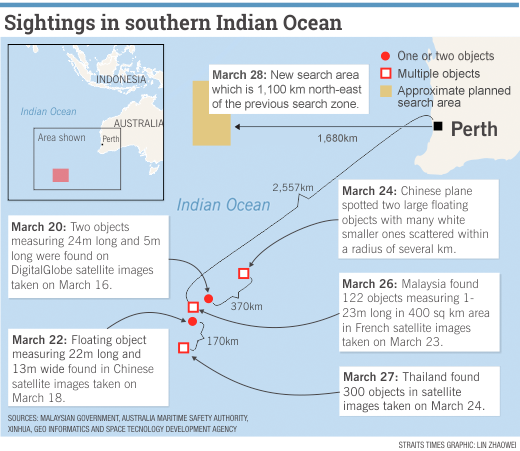PERTH (AFP) - A sea and air fleet is scouring the vast Indian Ocean for further underwater signals in the hunt for missing Malaysian Airlines flight MH370 as the plane's black box batteries reach the end of its advertised battery life on Monday.
Up to nine military planes, three civil planes and 14 ships are taking part in Monday's operation, Australia's Joint Agency Coordination Centre (JACC) said.
Three separate signals have been detected in the past days, raising hopes of solving the mystery of the plane, which disappeared on March 8 with 239 passengers and crew members on board.
Mr Angus Houston, head of the Australian-led search mission, said on Sunday that the signal detections were being taken "very seriously" as time ticked down on the black box tracking beacons.

He said Chinese vessel Haixun 01 had twice picked up an underwater signal on a frequency used for the plane's flight data and cockpit voice recorders - once for 90 seconds on Saturday and another more fleeting "ping" on Friday a short distance away.
A third "ping" was also being scrutinised, 300 nautical miles away, by the Australian vessel Ocean Shield.
"This is an important and encouraging lead but one which I urge you to continue to treat carefully," he told reporters on Sunday. "We are working in a very big ocean and within a very large search area."
Mr Houston said the Chinese finding was more promising.
"I think the fact that we've had two detections, two acoustic events in that location, provides some promise which requires a full investigation," he said.
Britain's Ministry of Defence confirmed late on Sunday that the HMS Echo, equipped to detect a black box, had arrived in the search area where the Chinese had reported a ping.
Mr Houston said Australian ship Ocean Shield - also equipped with a black box locator - and Australian air force planes were being diverted to the area to help discount or confirm the Chinese signals.
The search area was expected to be approximately 234,000 sq km on Monday, the JACC said in a statement, predicting good weather throughout the day.
The Malaysia Airlines Boeing 777, which vanished on March 8 during a flight from Kuala Lumpur to Beijing, is believed to have crashed into the southern Indian Ocean.
No debris has yet been found despite extensive aerial and sea searches, prompting authorities to switch to undersea acoustic surveillance in hopes of finding the aircraft.
The hunt for the jet was refocused on the southern end of the search zone on Sunday after corrected satellite data showed it was more likely the plane entered the water there.
Mr Houston said the Haixun 01 was already operating in that more southerly zone.
Some analysts greeted the acoustic detections with optimism, saying a 37.5kHz signal can only be transmitted by an emergency beacon. But others were sceptical and said it was vital to find supporting evidence.
Mr Houston said Haixun 01 was in waters about 4.5 km deep, meaning "any recovery operation is going to be incredibly challenging and very demanding and will take a long period of time" if the plane is found there. He added that time was critical.
"This is Day 30 of the search and the advertised time for the life of the batteries in the beacon is 30 days," he said on Sunday.
"Sometimes they last for several days beyond that - say eight to 10 days beyond that - but we're running out of time in terms of the battery life of the emergency locator beacons."
Mr Houston insisted that China was "sharing everything that's relevant to this search" with the lead authority, and sidestepped questions over the Haixun 01's location far from the other lead vessels in the search.

Mr Greg Waldron, Asia managing editor of Flightglobal, based in Singapore, said he was sceptical that the Chinese ship had picked up a pulse.
"There have been a lot of false leads in this story and we need to be extremely cautious with any information that comes," he told AFP.
Mr Ravi Madavaram, an aviation analyst with Frost & Sullivan in Kuala Lumpur, said most beacons used in the industry had the same frequency and the ping could "likely" be from flight MH370.
"But the Chinese have not said exactly where the 'ping' is originating and where they detected it," he said.
Malaysian authorities believe satellite readings indicate MH370 crashed in the Indian Ocean after veering dramatically off course for reasons that remain unknown.
A criminal probe has focused on hijacking, sabotage or psychological problems among passengers or crew, but there is no evidence yet to support any of the theories.



